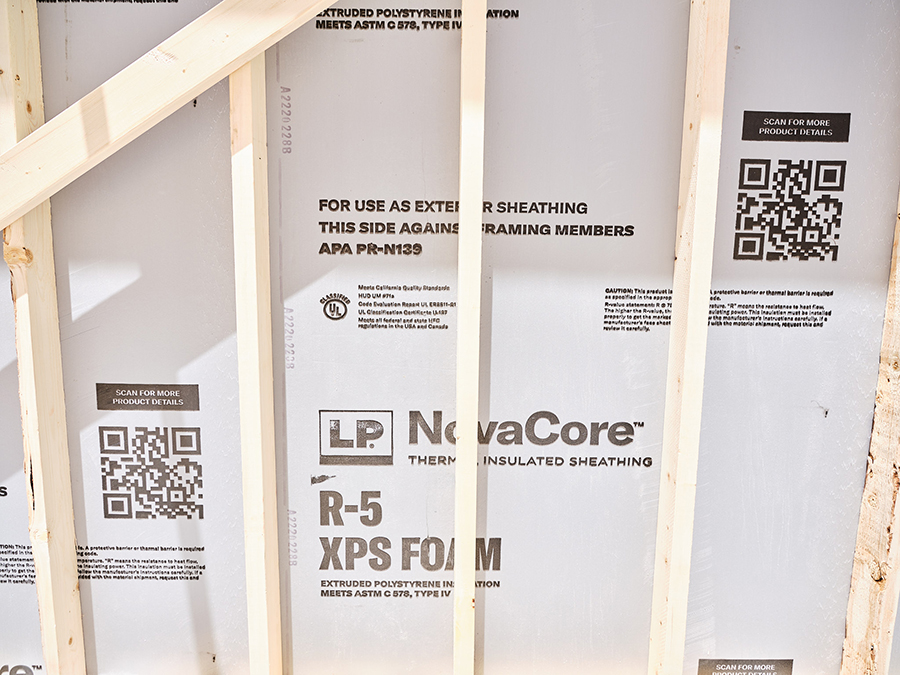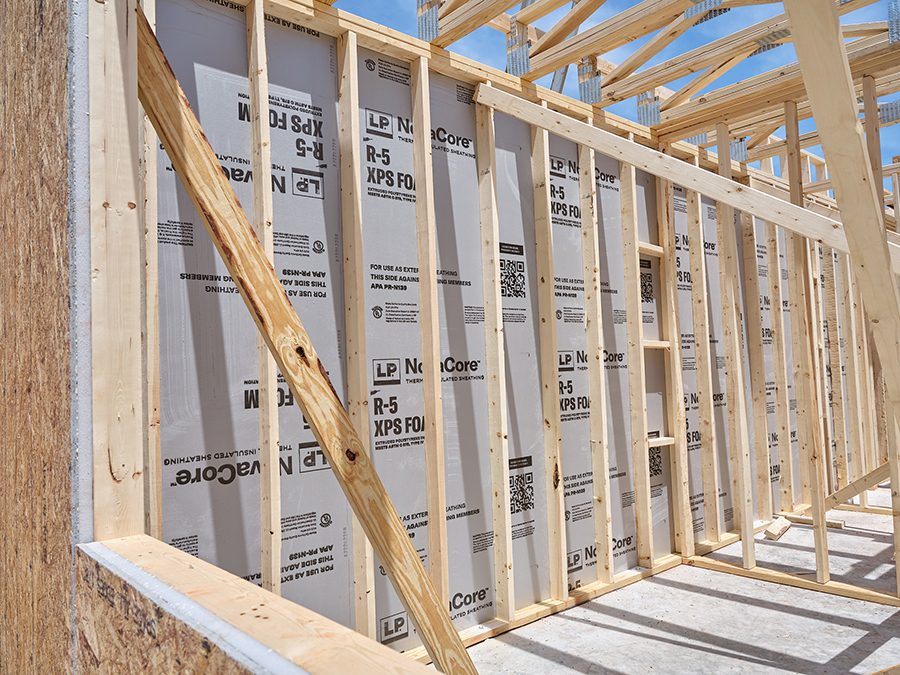Industry Trends6 min
A Deep Dive Into R-Values in Construction
Whether you're building net zero homes, focusing on energy efficiency or meeting local code when constructing single-family homes, it's important to understand how R-values work, what types of insulation have the highest R-value, and how to choose the best level of insulation for the job. Let's dive in and examine what R-values mean in construction.
What Do R-Values Mean and How Does Heat Flow?
R-value is the thermal resistance value based on a material's properties and thickness. Short for Resistance Value, R-value in construction is a measure of thermal resistance and how well a particular material keeps heat from moving into or out of a structure.
Heat flows in three ways: conduction, convection and radiation. It also flows from hot to cold. You experience conductive heat when you stir a hot cup of coffee with a metal spoon. The spoon gets hot because it's conducting the heat of the coffee into the spoon.
Convection is the movement in a gas or liquid where the warmer parts move up (heat rises) and the cooler parts move down. Radiant heat is the heat you sense, for instance, from a flame.
Regardless of what type of heat is flowing, warm air always moves to cooler areas. That means heated inside air flows into the unheated garage or outside. During summer, warm outside air flows into conditioned space. Without sufficient insulation, the HVAC must work harder to maintain the comfort of the people inside.
How Do R-Values Work and Do You Want a High or Low R-Value for Insulation?
Insulation is measured by its ability to resist conductive heat flow and is assigned an R-value. Each insulation material has its own R-value, which is determined by the type of insulation, its thickness and its density. The higher the R-value the better it is at resisting heat flow, so therefore higher R-values are preferred for insulation.
Installing more insulation increases the R-value and the resistance to heat flow. The amount of insulation or R-value needed depends on your climate zone, type of heating and cooling system, area building codes, and level of energy efficiency wanted by the homeowner.
Start by reviewing the climate zone map and chart detailing required R-values. The chart will indicate the R-value required for each area of the house in your zone.
What Insulation Has the Highest R-Value?
We turned to Neil Freidberg, Building Science Manager at LP Building Solutions, to learn about the different types of insulation and which ones ranked highest in R-value.
As it turns out, the market reviews rankings based on whether the insulation is used inside or outside the wall cavity. "Insulation with the highest R-value in the cavity is closed-cell spray foam or ccSPF, which is very expensive," says Freidberg. "Next, fiberglass, open-spray foam (coSPF) and mineral wool all compete at about the same R-value per inch. The insulation with the lowest R-value is cellulose. Outside the cavity, polyiso has a value of R-6 per inch. Next is XPS, which is extruded polystyrene, with a value of R-5 per inch. Last is EPS, or expanded polystyrene, at R-4 per inch, which has diverse uses. An example of EPS is the cheap polystyrene coolers that are thrown away after one use," explains Freidberg.
While wood isn't an insulation material, it too has an R-value. "Wood has a value of R-1 per inch," says Freidberg. "Without insulation, 2x4 is valued at about R-3 and 2x6 is about R-5, with roughly 25 percent of the house's wall is wood framing."
Which Insulation Type Is More Durable and Lasts Longer?
Selecting construction materials that endure is key to building resilient homes. While choosing insulation with a high R-value is critical, it's equally important the material can maintain its R-value over time.
"While polyiso has a higher R-value, expanded XPS is more durable," says Freidberg. "Polyiso uses a film on white foam board. If this film facer is ripped off, it can't maintain its gases. Additionally, some polyiso's gases condense into liquid at 55 degrees, reducing its R-value significantly at lower temperatures."
LP NovaCore™ Thermal Insulated Sheathing uses XPS foam to provide continuous insulation without the long-term R-value deterioration associated with some other foam insulation products. While other polyiso foam products decrease their R-value as temperatures drop, LP NovaCore sheathing with XPS foam increases R-value as temperatures plunge.

Why Choose Insulation With a Higher R-Value in Construction?
Using superior insulation in your customers' homes will pay off over the lifetime of their homes. Not only will they appreciate lower monthly utility bills, but HVAC units can be spec'd smaller and even last longer.
Freidberg offers this analogy: "If it's 32 degrees Fahrenheit outside and I give you a light jacket, you're still going to be cold. Your body has to produce more energy to keep you warm. If I give you a bigger, heavier coat, it reduces the heat exiting your body. You're more comfortable and not as tired at the end of the day."
A better insulated home reduces the cost of operation and even the cost of equipment. "If the structure needs a 5-ton HVAC unit, better insulation--or a heavier coat--could mean going with a smaller 2.5- or 3-ton HVAC, which saves money," explains Freidberg.
What Is Continuous Insulation and Why Is It Needed?
Most builders are very familiar with in-cavity insulation materials like fiberglass batting. However, wherever insulation can't be installed--like electrical boxes, nooks and crannies, and where materials meet-these areas experience tremendous thermal bridging or heat transfer.
To combat thermal bridging energy-efficient builders turn to continuous insulation, like LP NovaCore Thermal Insulated Sheathing.

Why? Insulating with R-15 fiberglass doesn't make the entire wall exterior an R-15. There's a difference between nominal and actual.
"Cavities can be insulated at R-13 to R-15 for a 2x4 wall. But that doesn't mean the entire house is insulated to R-13 to R-15; the effective R-value is only R-9 to R-11," says Freidberg. "By adding one inch of XPS continuous insulation, you are decreasing thermal bridging and increasing the effective R-value so you can have an R-14 to R-16 exterior wall. Even though a 2x4 wall assembly is filled with R-15 insulation, about 25 percent of the wall is wood framing, which is R-3. That means 75 percent of your wall is insulated and 25 percent is not."
"Let's go back to our analogy of wearing a light jacket. If it's a striped jacket and 25 percent doesn't have any material, it's not going to be enough to guard against the cold," explains Freidberg.
Ultimately, LP NovaCore Thermal Insulated Sheathing gives the homeowner better performance and increases the comfort of the home by adding continuous insulation to the build.
Looking for more? Learn how climate change is shaping the change of homebuilding.
Continue Reading
Resiliency Solutions
5 minIntroducing LP® SmartSide® ExpertFinish® Naturals Collection™: Nature-Inspired Beauty Meets Engineered Performance
We’re excited to introduce the LP® SmartSide® ExpertFinish® Naturals Collection™, a bold new addition to our trusted line of engineered wood siding and trim that delivers the warmth and beauty of nature with the advanced protection and performance builders and homeowners expect.
Labor Solutions
5 minChoosing the Right LP® Structural Solutions Product for Your Build
When it comes to building strong, reliable, and high-performing structures, the materials you choose matter. At LP Building Solutions, we understand that every project, whether it's a single-family home or a multifamily development, requires structural components that meet your needs for strength, durability, and efficiency.
Sustainability Solutions
5 minBuilding a More Sustainable Future with LP Building Solutions
In today's world, sustainability is no longer just a buzzword, it's a blueprint for responsible living and smarter building. As the construction industry seeks ways to reduce its environmental footprint, LP Building Solutions is focused on providing innovative building materials for eco-conscious builders to help reshape what it means to build sustainably
News & Stories3 min
History of Partnership with Gary Sinise Foundation
The LP Foundation is a proud partner of the Gary Sinise Foundation, which supports wounded veterans in several ways. You can learn more about the LP Foundation here.